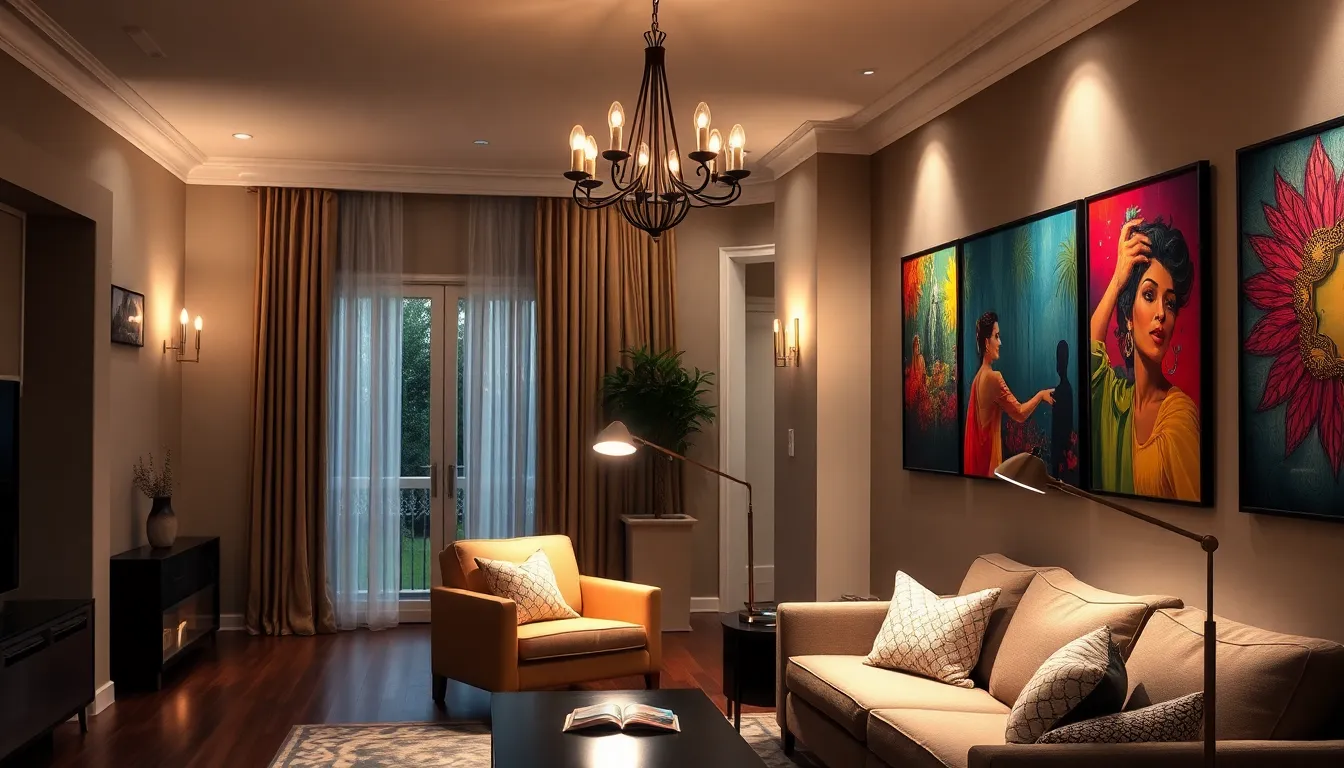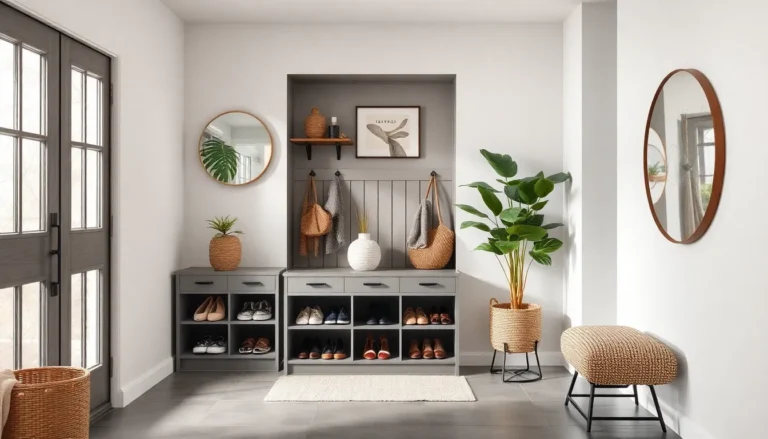When it comes to interior lighting, it’s not just about flipping a switch; it’s about setting the mood, creating ambiance, and occasionally avoiding tripping over the coffee table. Good lighting can transform a drab space into a cozy haven or a vibrant gathering spot. Think of it as the unsung hero of home design, tirelessly working behind the scenes to elevate every corner of your living space.
Table of Contents
ToggleImportance of Interior Lighting
Interior lighting plays a vital role in home design, impacting both aesthetics and functionality. Effective lighting transforms spaces, elevating mood and enhancing ambience.
Enhancing Aesthetics
A well-thought-out lighting plan showcases architectural elements. It highlights artwork and furniture, creating visual interest. Mood lamps and layered lighting create inviting atmospheres. Designers use colors and brightness levels to set varying tones. Warm tones often evoke comfort, while cooler tones promote focus. Natural light complements interior décor, creating cohesive looks. Specific fixtures act as statement pieces, drawing attention and adding character.
Improving Functionality
Effective lighting increases the usability of a space. It aids tasks like reading and cooking by providing required illumination. Layered lighting addresses different activities, ensuring each area meets specific needs. For example, dimmable options adapt to varying moods and requirements. Adequate lighting reduces accidents, improving overall safety. Proper placement of fixtures enhances visibility, ensuring efficient use of space. Considering the intended function of each room leads to better lighting choices.
Types of Interior Lighting

Interior lighting enhances both aesthetics and functionality within a space. Different types of lighting serve various purposes, creating a dynamic atmosphere.
Ambient Lighting
Ambient lighting provides overall illumination in a room. It establishes a base layer of light essential for daily activities. Common sources include ceiling fixtures, chandeliers, and wall sconces. This type of lighting ensures even distribution throughout the area. Without effective ambient lighting, spaces can appear dull or uninviting. Warm tones in ambient lighting encourage relaxation, while cooler tones promote focus. Choosing the right intensity supports the room’s functionality, making it suitable for various uses.
Task Lighting
Task lighting focuses light where it is most needed, enhancing activities like reading or cooking. Desk lamps and under-cabinet lights are popular examples. Adjustable fixtures allow users to direct light toward specific areas. Bright, focused light enhances visibility, minimizing eye strain during tasks. Proper placement is crucial to avoid shadows that may disrupt activities. Selecting energy-efficient bulbs can improve the sustainability of task lighting options. Achieving the right balance of brightness ensures comfort and efficiency for specific tasks.
Accent Lighting
Accent lighting adds visual interest by highlighting specific features in a room. It draws attention to artwork, architectural details, or plants. Recessed lights, track lights, and wall-mounted fixtures can serve this purpose effectively. The focused illumination creates depth and drama within a space. Using dimmers with accent lighting can adjust the mood according to different occasions. This type of lighting plays a crucial role in setting an atmosphere that complements the overall design. Strategic placement of accent lights enhances the room’s character and personal touch.
Factors to Consider in Interior Lighting
When planning interior lighting, several key factors influence the overall effect on space. Understanding these factors ensures both beauty and functionality.
Color Temperature
Color temperature plays a vital role in setting the ambiance. Measured in Kelvin, lower Kelvin values like 2700K provide a warm light that fosters comfort, while higher values such as 5000K emit cool light that promotes focus. Designers often recommend using warm tones in living areas to create a cozy environment. In contrast, workspaces benefit from cooler tones to enhance concentration. Customizing the color temperature according to room function helps achieve the desired atmosphere.
Fixture Design
Fixture design complements the overall aesthetics of a room. Selecting the right fixtures enhances both the style and effectiveness of lighting. Options range from pendant lights to wall sconces, each adding unique character. Chandeliers provide elegance, while recessed lighting focuses on functionality. Considering scale and proportion ensures that fixtures fit harmoniously within the space. A well-chosen design not only illuminates but also serves as a standout feature in the interior.
Energy Efficiency
Energy efficiency has become increasingly important in lighting choices. Opting for LED bulbs significantly reduces energy consumption, making them a sustainable option. These bulbs last longer than traditional incandescent ones, saving on replacement costs. Energy Star-rated products ensure maximum efficiency while maintaining optimal light quality. Choosing energy-efficient solutions impacts both utility bills and environmental sustainability, aligning lighting choices with eco-friendly practices.
Trends in Interior Lighting Design
Interior lighting design trends focus on innovation, sustainability, and smart technology. Designers increasingly adapt spaces to meet modern needs while enhancing aesthetics through lighting.
Smart Lighting Solutions
Integration of smart technology in lighting solutions revolutionizes how homeowners control their environments. Smart bulbs and fixtures enable users to adjust brightness, color, and scheduling through mobile apps or voice commands. Control options include dimmable settings to match various moods and activities. Setting scenes for entertaining or relaxing becomes effortless. Moreover, automation features such as motion sensors provide energy savings by turning lights on or off as needed. This technology enhances not only convenience but also the overall efficiency of lighting systems.
Sustainable Lighting Options
Sustainability drives the adoption of eco-friendly lighting solutions in spaces. LED bulbs stand out for their energy efficiency, consuming up to 75% less energy than traditional incandescent bulbs. This efficiency translates to reduced electricity bills and longer lifespans, often exceeding 25,000 hours. Using recycled materials in fixture design promotes responsible consumption. Biodegradable options and low-impact lighting materials also emerge as popular choices among environmentally-conscious designers. These sustainable practices align interior lighting with broader goals of environmental stewardship while maintaining attractive aesthetics.
Interior lighting is a vital aspect of home design that significantly influences both the atmosphere and functionality of a space. By thoughtfully selecting and layering different types of lighting, homeowners can create environments that cater to various moods and activities.
The integration of natural light and smart technology enhances the overall experience while promoting energy efficiency. As trends evolve, embracing sustainability and innovative designs becomes essential for a modern aesthetic.
Ultimately, a well-planned lighting strategy not only elevates a home’s visual appeal but also improves its usability, ensuring that every room serves its intended purpose effectively.



